Roofing Companies Dukinfield
Best Roofing Service in Dukinfield
Get multiple Roofers quotes for your project today! Compare profiles, reviews, accreditations, portfolio, etc... and choose the best offer.
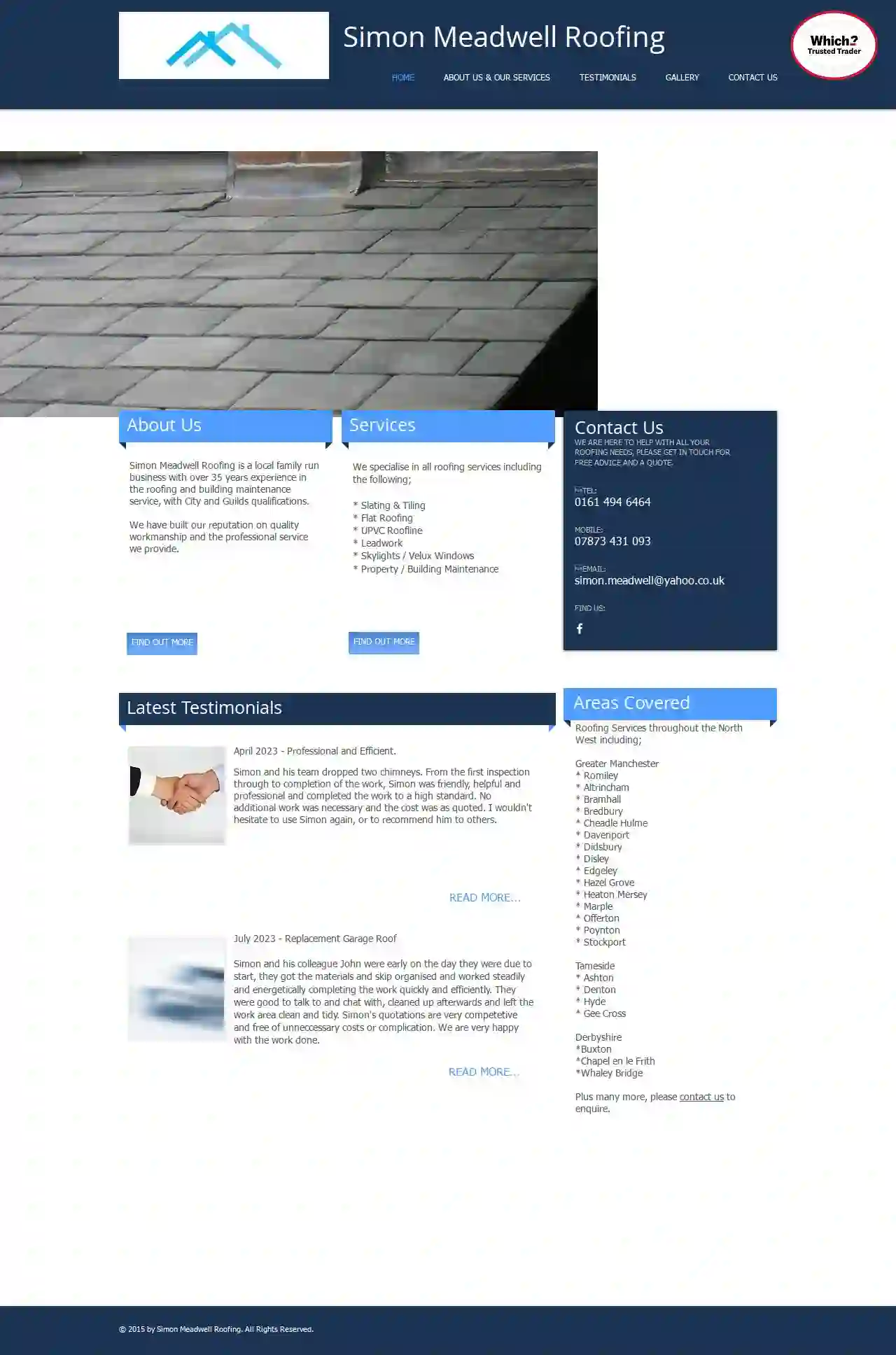
Simon Meadwell Roofing
53 reviewsStockport, GBSimon Meadwell Roofing is a family-run business with over 35 years of experience in roofing and building maintenance. They are based in the North West and hold City and Guilds qualifications. The company prides itself on quality workmanship and professional service.
- Services
- Why Us?
- Our Team
- Testimonials
- Gallery
Get Quote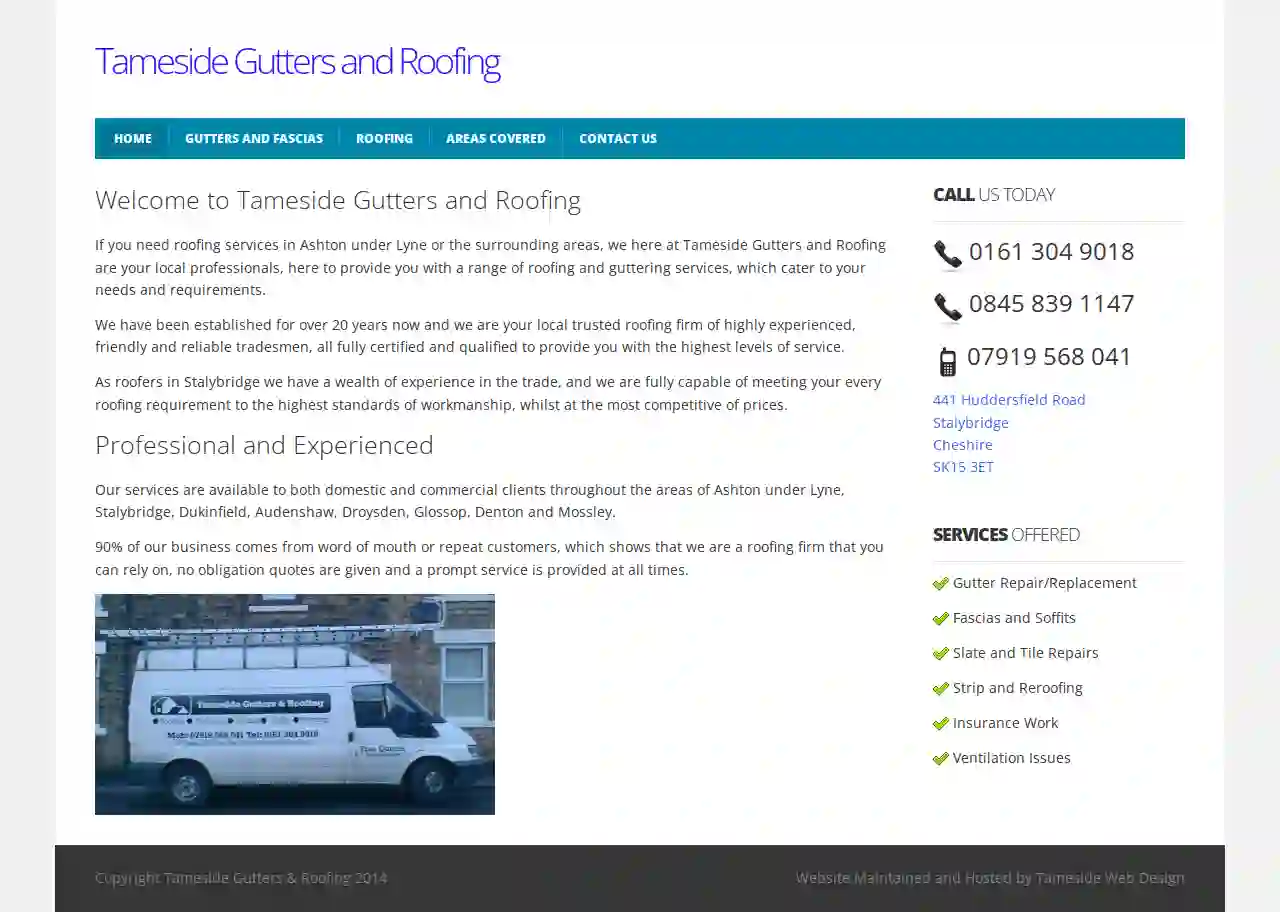
Tameside Gutters and Roofing
4.69 reviews441 Huddersfield Road, Stalybridge, SK15 3et, GBWelcome to Tameside Gutters and Roofing. If you need roofing services in Ashton under Lyne or the surrounding areas, we here at Tameside Gutters and Roofing are your local professionals, here to provide you with a range of roofing and guttering services, which cater to your needs and requirements. We have been established for over 20 years now and we are your local trusted roofing firm of highly experienced, friendly and reliable tradesmen, all fully certified and qualified to provide you with the highest levels of service. As roofers in Stalybridge we have a wealth of experience in the trade, and we are fully capable of meeting your every roofing requirement to the highest standards of workmanship, whilst at the most competitive of prices. Our services are available to both domestic and commercial clients throughout the areas of Ashton under Lyne, Stalybridge, Dukinfield, Audenshaw, Droysden, Glossop, Denton and Mossley. 90% of our business comes from word of mouth or repeat customers, which shows that we are a roofing firm that you can rely on, no obligation quotes are given and a prompt service is provided at all times.
- Services
- Why Us?
- Our Team
- Gallery
Get Quote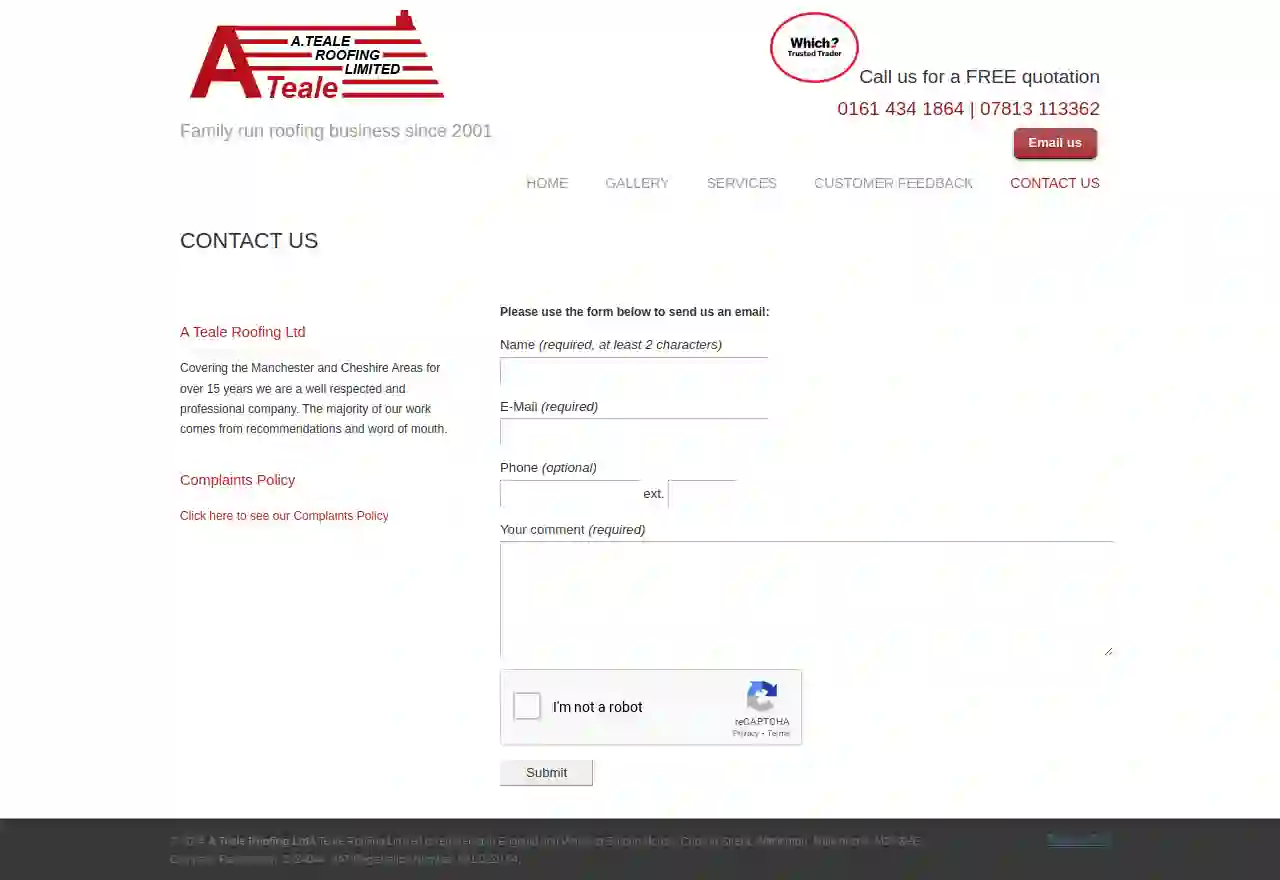
A Teale Roofing Ltd
4.511 reviewsSurcon House, Copson Street, Withington, M20 3HE, GBWelcome to A Teale roofing. A family run business since 2001. We have grown as a family business to become the established and trusted roofing company we are today. A TEALE ROOFING LIMITED Roofing specialists for all types of replacement and repair. Professional A Teale Roofing LImited meet the needs and requirements of you the customer and provide solutions to all of your roofing problems. Do not hesitate to call us today for a free estimate. Reliable Providing roofing services in the Manchester and Cheshire areas for over 20 years we are a well respected and professional company and the majority of our work comes from recommendations and word of mouth. Competitive As an employer we ensure that our team of skilled roofers work to a safe standard, while maintaining a high quality service - the type you would expect from a team that possesses expertise in all areas of the roofing industry. What We Do We cover all types of roofing From full re-roofs to storm damage repairs, we pride ourselves on our old-fashioned approach to customer service which ensures that we respond quickly, at your convenience and that we fully explain everything we do. Whether you are in the early stages of planning, or ready to start a project. Do not hesitate to call us today for a free estimate. We will be happy to answer any questions or queries you may have.
- Services
- Why Us?
- Accreditations
- Our Team
- Testimonials
- Gallery
Get Quote
The Bramhall Rubber Roofing Company
GBEast Cheshire Roofing Network is a group of dedicated roofing professionals serving the East Cheshire area. We offer a comprehensive range of roofing services for both residential and commercial properties, including roof repairs, flat roofing, pitched roofing, fascias and soffits, and more. Our team of experienced roofers is committed to providing high-quality workmanship and exceptional customer service. We understand the importance of a well-built roof, and we take pride in ensuring that our clients have a safe and secure home or business. Whether you need a small repair or a complete roof replacement, East Cheshire Roofing Network is here to help. Contact us today for a free quote and let us take care of all your roofing needs.
- Services
- Why Us?
- Accreditations
- Our Team
- Testimonials
- Gallery
Get Quote
Just Roofing Supplies
4.747 reviewsRoundthorn Industrial Estate, Unit 3, Dallimore Road, Wythenshawe, M23 9NX, GBWith 30 years experience in the roofing industry, Just Roofing Supplies Ltd can offer you friendly expert advice on all kinds of roofing. From advice on the most reliable brands to the best materials to use in different situations, we can help. Call us on 0161 998 6777 or get in touch through the website.
- Services
- Why Us?
- Gallery
Get Quote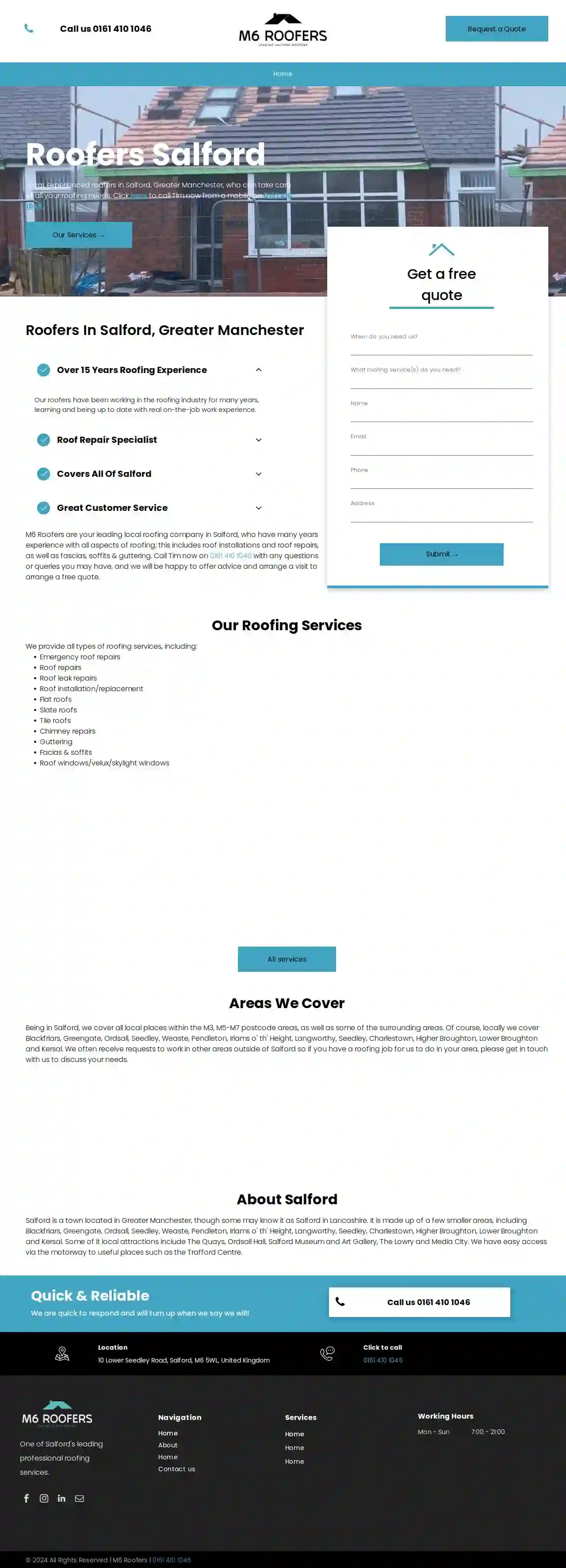
M6 Roofers
55 reviews10 Lower Seedley Road, Salford, M6 5WL, GBM6 Roofers are your leading local roofing company in Salford, who have many years experience with all aspects of roofing; this includes roof installations and roof repairs, as well as fascias, soffits & guttering. We provide all types of roofing services, including emergency roof repairs, roof repairs, roof leak repairs, roof installation/replacement, flat roofs, slate roofs, tile roofs, chimney repairs, guttering, facias & soffits, and roof windows/velux/skylight windows. Our roofers have been working in the roofing industry for many years, learning and being up to date with real on-the-job work experience. We are based in M6 Salford, and work here and all surrounding Salford areas, including Seedley, Irlams o' th' Height, Higher & Lower Broughton, Worsley and Wardley. We provide a high quality yet easy personable experience, and are quick to respond and will turn up when we say we will!
- Services
- Why Us?
- Gallery
Get Quote
5 star roofing manchester
52 reviews10 Beaufort Street, Manchester, M25 1EX, GBReputable Roofing services in & around Manchester. From a slipped slate to a full re roof you can trust 5 Star Roofing to carry out your roof repairs with integrity and the minimum of fuss. We pride ourselves on our honest approach. Our advice is free, and always un-biased and with the customers best interests always in our mind. Our track record for being punctual and courteous is unmatched. Our customers know we keep to our promises. We deliver on each & every project. We have an enviable reputation around the surrounding areas, with much of our work coming from recommendations and repeat business. Our hand picked materials we use are of the very highest quality. These small touches will provide a far superior finish that can stand the test of time. We have been working on domestic properties in and around the Manchester area for over 20 years. We always aim to provide a service to the home owner, that offers minimum disruption and maximum efficiency.Roofers in ManchesterWe provide free quotations so if it's repairs, re roofs or general maintenance we will always provide you with a no nonsense honest assessment and exactly how much it will cost. It is also standard practice of ours to take before and after photographs of any areas we are quoting and working on, giving our customers piece of mind.Looking for a no obligation quote?We have over 20 years’ experience to call upon in all areas of roofing.All our work carries a minimum 10 year guarantee. This guarantee covers the workmanship carried out and also the materials we have used.Ensure you have your Roof
- Services
- Why Us?
- Testimonials
- Gallery
Get Quote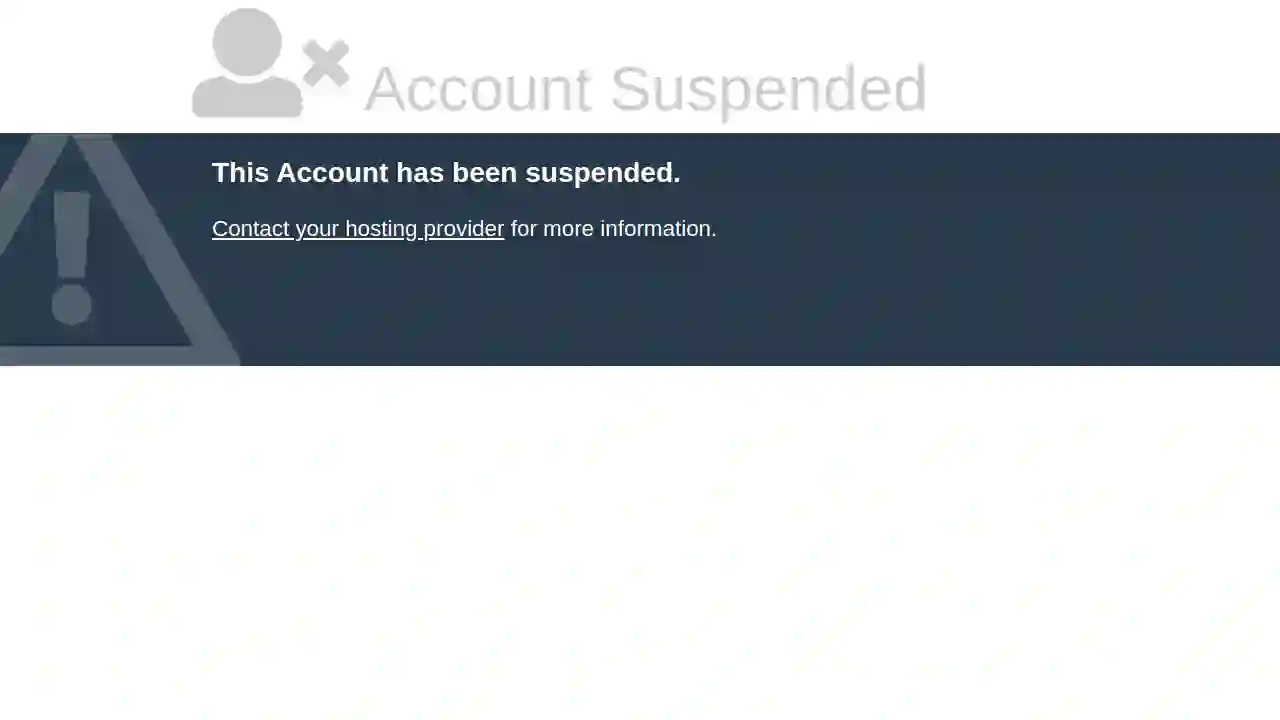
The Roofing Firm
48 reviews2 Alt Rd, Ashton-Under-Lyne, OL6 8TS, GBWe are a well-established, local, family run roofing company with a strong reputation for offering excellent service, promptly and within budget. We have successfully repaired all kinds of pitched and flat roofs for houses, apartments and businesses over many years. Whether you require a Roof Repair or indeed a complete Roof Installation, regardless of the size of the roofing project, we guarantee that we will always complete your roofing project to the highest possible standard.
- Services
- Why Us?
- Our Team
- Testimonials
- Gallery
Get Quote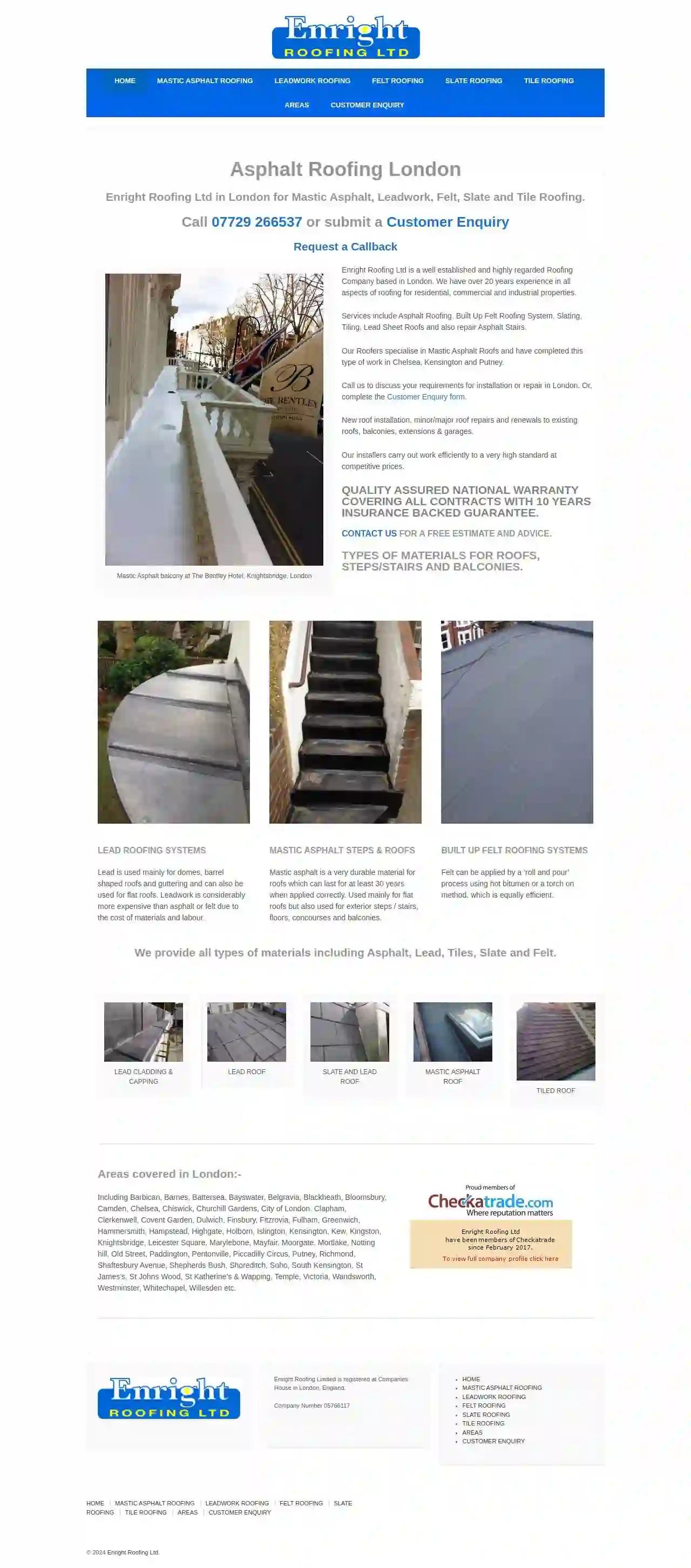
Enright Roofing Ltd
GBEnright Roofing Ltd is a well established and highly regarded Roofing Company based in London. We have over 20 years experience in all aspects of roofing for residential, commercial and industrial properties. Our Roofers specialise in Mastic Asphalt Roofs and have completed this type of work in Chelsea, Kensington and Putney. We provide all types of materials including Asphalt, Lead, Tiles, Slate and Felt. Our installers carry out work efficiently to a very high standard at competitive prices.QUALITY ASSURED NATIONAL WARRANTY COVERING ALL CONTRACTS WITH 10 YEARS INSURANCE BACKED GUARANTEE.
- Services
- Why Us?
- Gallery
Get Quote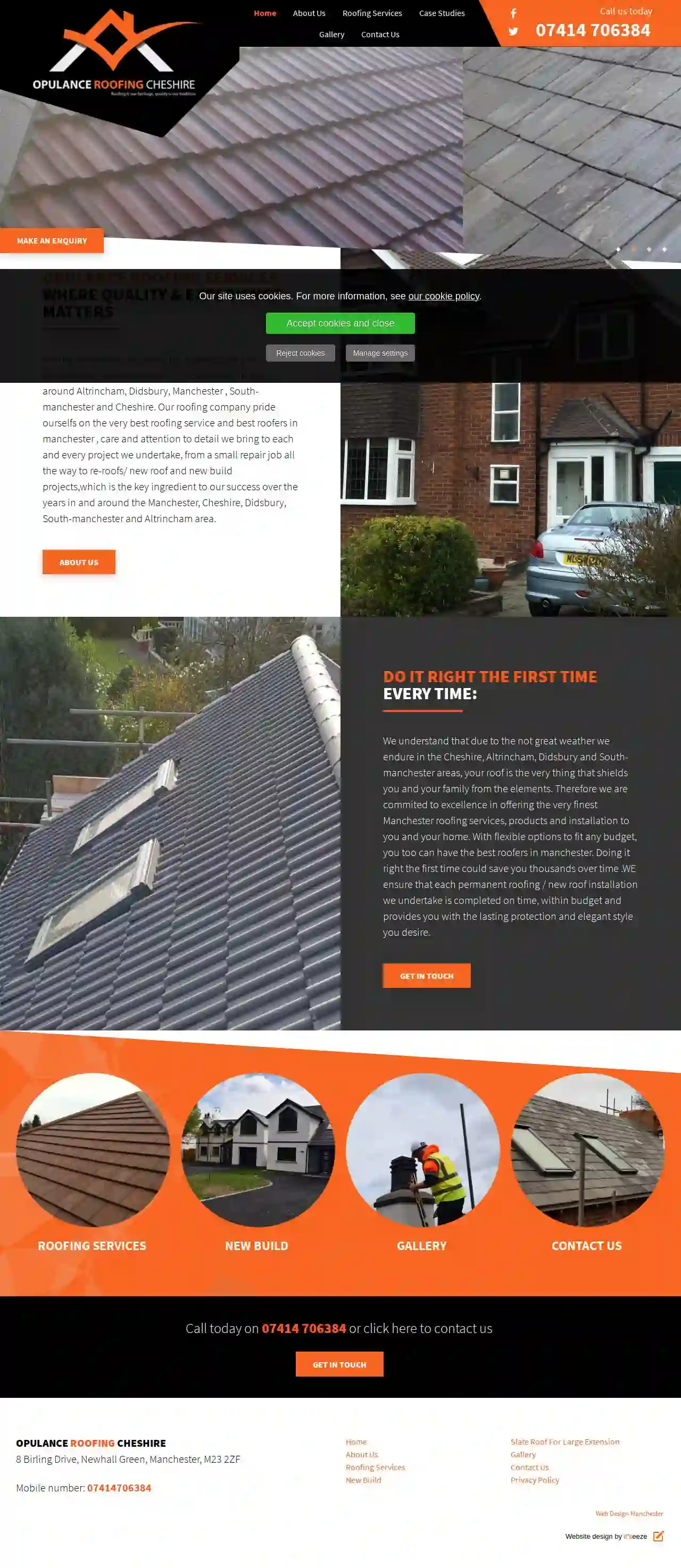
Opulance roofing cheshire
4.815 reviewsNewhall Green, 8 Birling Drive, Manchester, M23 2ZF, GBOpulance Roofing Services is a family-run roofing company serving the areas around Didsbury, Altrincham, Chorlton, and Cheshire. We pride ourselves on providing a superior roofing service and customer value as one of the best roofers in Manchester. Our approach is grounded in a commitment to quality and excellence, ensuring that every job is completed to the highest standard. With over 15 years of experience, we have assembled a team of incredibly talented professional tradesmen. We understand that your roof is crucial in protecting you and your family from the elements, especially considering the unpredictable weather in the Cheshire, Altrincham, Didsbury, and South-manchester areas. That's why we are dedicated to offering the finest roofing services, products, and installation to ensure lasting protection and elegant style for your home. Whether you need a small repair, a full re-roof, or a new build project, we have the expertise and experience to handle it all. We offer flexible options to fit any budget and strive to do the job right the first time, saving you time and money in the long run. At Opulance Roofing Cheshire, we believe in quality first and foremost. Our systems are in place to ensure that materials are used correctly and that every aspect of the project meets the highest standards. We inspect, test, evaluate, and verify everything to guarantee a durable and reliable roof. Contact us today for a free consultation and let us help you find the best roofing solution for your needs.
- Services
- Why Us?
- Gallery
Get Quote
Over 12,314+ Roofing Businesses onboarded
Our roofing experts operate in Dukinfield and beyond!
Roofyng.co.uk has curated and vetted the Best Roofers in and around Dukinfield. Find a reliable contractor today.
Frequently Asked Questions About Roofing Companies
- Style: Consider your home's architectural style and choose a roofing material that complements it.
- Climate: Factor in your local climate conditions. Some materials perform better in extreme heat, cold, or high winds than others.
- Budget: Roofing materials have a wide range of costs. Determine your budget and choose materials that fit your financial constraints.
- Durability and Lifespan: Assess the expected lifespan and durability of different materials.
- Energy Efficiency: Choose materials with good insulation and reflectivity properties to improve your home's energy efficiency.
- Sagging or Pulling Away: Gutters that are sagging, pulling away from the house, or visibly damaged need repairs or replacement.
- Overflowing Water: If water overflows during rain, it indicates clogs or inadequate drainage.
- Visible Debris: Leaves, twigs, and other debris accumulated in the gutters obstruct water flow.
- Water Damage: Water stains or damage to siding or foundation near the gutters suggest overflow.
- Plant Growth: Plants or moss growing in the gutters indicate standing water and the need for cleaning.
- Choose Reflective Roofing Materials: Opt for light-colored shingles or metal roofing that reflects sunlight and reduces heat absorption.
- Install Proper Attic Insulation: Adequate insulation prevents heat loss in the winter and heat gain in the summer.
- Ensure Adequate Ventilation: Proper attic ventilation allows hot air to escape, reducing cooling costs and extending the lifespan of your roof.
- Consider a Radiant Barrier: In hot climates, a radiant barrier installed in the attic can reflect heat away from the roof, further reducing cooling needs.
- Experience: 'How long have you been in business, and what experience do you have with my type of roof?'
- Licensing and insurance: 'Are you licensed and insured, and can I see proof of coverage?'
- Warranties: 'What warranties do you offer on your work and the materials used?'
- References: 'Can you provide references from past clients?'
- Project Timeline: 'What is the estimated timeline for completing the project?'
- Payment Terms: 'What are your payment terms, and do you require a deposit?'
- Communication: 'How will you keep me updated on the project's progress?'
- Cleanup: 'What steps will you take to protect my property during the project and ensure proper cleanup afterward?'
How do I choose the right roofing materials for my home?
How can I tell if my gutters need to be cleaned or repaired?
How can I make my new roof more energy-efficient?
What questions should I ask a roofing contractor?
How do I choose the right roofing materials for my home?
- Style: Consider your home's architectural style and choose a roofing material that complements it.
- Climate: Factor in your local climate conditions. Some materials perform better in extreme heat, cold, or high winds than others.
- Budget: Roofing materials have a wide range of costs. Determine your budget and choose materials that fit your financial constraints.
- Durability and Lifespan: Assess the expected lifespan and durability of different materials.
- Energy Efficiency: Choose materials with good insulation and reflectivity properties to improve your home's energy efficiency.
How can I tell if my gutters need to be cleaned or repaired?
- Sagging or Pulling Away: Gutters that are sagging, pulling away from the house, or visibly damaged need repairs or replacement.
- Overflowing Water: If water overflows during rain, it indicates clogs or inadequate drainage.
- Visible Debris: Leaves, twigs, and other debris accumulated in the gutters obstruct water flow.
- Water Damage: Water stains or damage to siding or foundation near the gutters suggest overflow.
- Plant Growth: Plants or moss growing in the gutters indicate standing water and the need for cleaning.
How can I make my new roof more energy-efficient?
- Choose Reflective Roofing Materials: Opt for light-colored shingles or metal roofing that reflects sunlight and reduces heat absorption.
- Install Proper Attic Insulation: Adequate insulation prevents heat loss in the winter and heat gain in the summer.
- Ensure Adequate Ventilation: Proper attic ventilation allows hot air to escape, reducing cooling costs and extending the lifespan of your roof.
- Consider a Radiant Barrier: In hot climates, a radiant barrier installed in the attic can reflect heat away from the roof, further reducing cooling needs.
What questions should I ask a roofing contractor?
- Experience: 'How long have you been in business, and what experience do you have with similar projects?'
- Licensing and insurance: 'Are you licensed and insured, and can I see proof of coverage?'
- Warranties: 'What warranties do you offer on your work and the materials used?'
- References: 'Can you provide references from past clients?'
- Project Timeline: 'What is the estimated timeline for completing the project?'
- Payment Terms: 'What are your payment terms, and do you require a deposit?'
- Communication: 'How will you keep me updated on the project's progress?'
- Cleanup: 'What steps will you take to protect my property during the project and ensure proper cleanup afterward?'